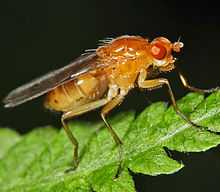Dryomyzidae
| Dryomyzidae | |
|---|---|
 | |
| Dryomyzid Fly - Dryomyza sp.[1][2] | |
| Scientific classification | |
| Kingdom: | Animalia |
| Phylum: | Arthropoda |
| Class: | Insecta |
| Order: | Diptera |
| Suborder: | Brachycera |
| Section: | Schizophora |
| Subsection: | Acalyptratae |
| Superfamily: | Sciomyzoidea |
| Family: | Dryomyzidae Schiner, 1862 [3] |
| Genera | |
|
See Text | |
Dryomyzidae is a small family of flies ranging from 4-18mm long, with prominent bristles, and yellow to brown or rust-yellow coloring.The wings are very large.The subcosta is complete and well separated from vein 1.Larvae feed on decaying organic matter; carrion, dung, and fungi.[3] The prelambrum protrudes from the oral cavity.Vibrissae are absent and the postvertical bristles are divergent.[4]
There are approximately 22 species in 6 genera (with two additional genera known only as fossils). Dryomyzid flies are found principally in the Holarctic though some are found in the Southern Hemisphere. Very little is known of the habits of the adults or immatures but adults are found in moist, shady habits among low-growing vegetation.[3]
Classification
- D. amblia Kurahashi, 1981 [3]
- D. anilis Fallén, 1820 [3]
- D. badia Kurahashi, 1981 [3]
- D. caucasica Ozerov, 1987 [3]
- D. ecalcarata Kurahashi, 1981 [3]
- D. formosa (Wiedemann, 1830) [3]
- D. pakistana Kurahashi, 1989 [3]
- †D. pelidua Statz, 1940 [3]
- D. puellaris Steyskal, 1957 [3]
- †D. shanwangensis Zhang, 1989 [3]
- D. simplex Loew, 1862 [3]
- D. takae Azuma, 2001 [3]
- Genus: Dryope Robineau-Desvoidy, 1830 [3]
- D. decrepita (Zetterstedt, 1838) [3]
- D. flaveola (Fabricius, 1794) [3]
- D. melanderi (Steyskal, 1957) [3]
- Genus: Oedoparena Curran, 1934 [3]
- O. glauca (Coquillett, 1900) [3][5]
- O. minor Suwa, 1981[3][6]
- O. nigrifrons Mathis and Steyskal, 1980[3][7]
- Genus: †Palaeotimia Meunier, 1908 [3]
- †P. ihoesti Meunier, 1908 [3]
- Genus: Paradryomyza Ozerov, 1987 [3]
- Genus: Pseudoneuroctena Ozerov, 1987 [3]
- P. senilis (Zetterstedt, 1846) [3]
- Genus: Steyskalomyza Kurahashi, 1982 [3]
- S. hasegawai Kurahashi, 1982 [3]
Nomina dubia
Distribution/Species Lists
Identification
- Steyskal GC (1957) A revision of the family Dryomyzidae (Diptera,. Acalyptratae). Pap. Mich. Acad. Sci. 42:55–68. World revision. Species keys.
- Czerny, L. (1930), Dryomyzidae und Neottiophilidae. 38b. In: Lindner, E. (Ed.). Die Fliegen der Palaearktischen Region 5(1): 1–18. Keys to Palaearctic species (in German).
Fossil Record
Only four fossil species in three genera (all from the Tertiary) are known.[3][8]
External links
| Wikispecies has information related to: Dryomyzidae |
| Wikimedia Commons has media related to Dryomyzidae. |
References
- ↑ Cirrus Digital: Family Dryomyzidae
- ↑ Bugguide.net Dryomyza species
- ↑ 3.0 3.1 3.2 3.3 3.4 3.5 3.6 3.7 3.8 3.9 3.10 3.11 3.12 3.13 3.14 3.15 3.16 3.17 3.18 3.19 3.20 3.21 3.22 3.23 3.24 3.25 3.26 3.27 3.28 3.29 3.30 3.31 3.32 3.33 3.34 3.35 3.36 3.37 3.38 3.39 3.40 Mathis, Wayne N.; Sueyoshi, Masahiro (2011). "World Catalog and Conspectus on the Family Dryomyzidae (Diptera: Schizophora)". Myia (PDF) 12: 207–233.
- ↑ Shtakel'berg, A.A. Family Driomyzidae in Bei-Bienko, G. Ya, 1988 Keys to the insects of the European Part of the USSR Volume 5 (Diptera) Part 2 English edition.
- ↑ Burger, J.F.; Anderson, J.R. & Knudsen, M.F. (1980). "The habits and life history of Oedoparena glauca (Diptera: Dryomyzidae), a predator of barnacles". Proe. entomol. Soc. Wash. (Print) 82: 360–377.
- ↑ Suwa, Masaaki (1981). "Description of a new Japanese species of Oedoparena, an Asio-American dipterous genus (Dryomyzidae)" (pdf). Insecta Matsumurana. New Series (Hokkaido, Japan: Hokkaido University) 20: 29–35.
- ↑ Mathis, W.N.; Steyskal, G.C. (1980). "A revision of the genus Oedoparena Curran (Diptera: Dryomyzidae; Dryomyzinae).". Proe. entomol. Soc. Wash. (Print) (Washington, U.S.) 82: 349–359.
- ↑ Hawaii Biological Survey: Family Dryomyzidae
| ||||||||||||||||||||||||||||||||||||||||||||||||||||||||||||||||||||||||||||||||||||||||||||||||||||||||||||||||||||||||||||||||||||||||||||||||||||||||||||||||||||||||||||||